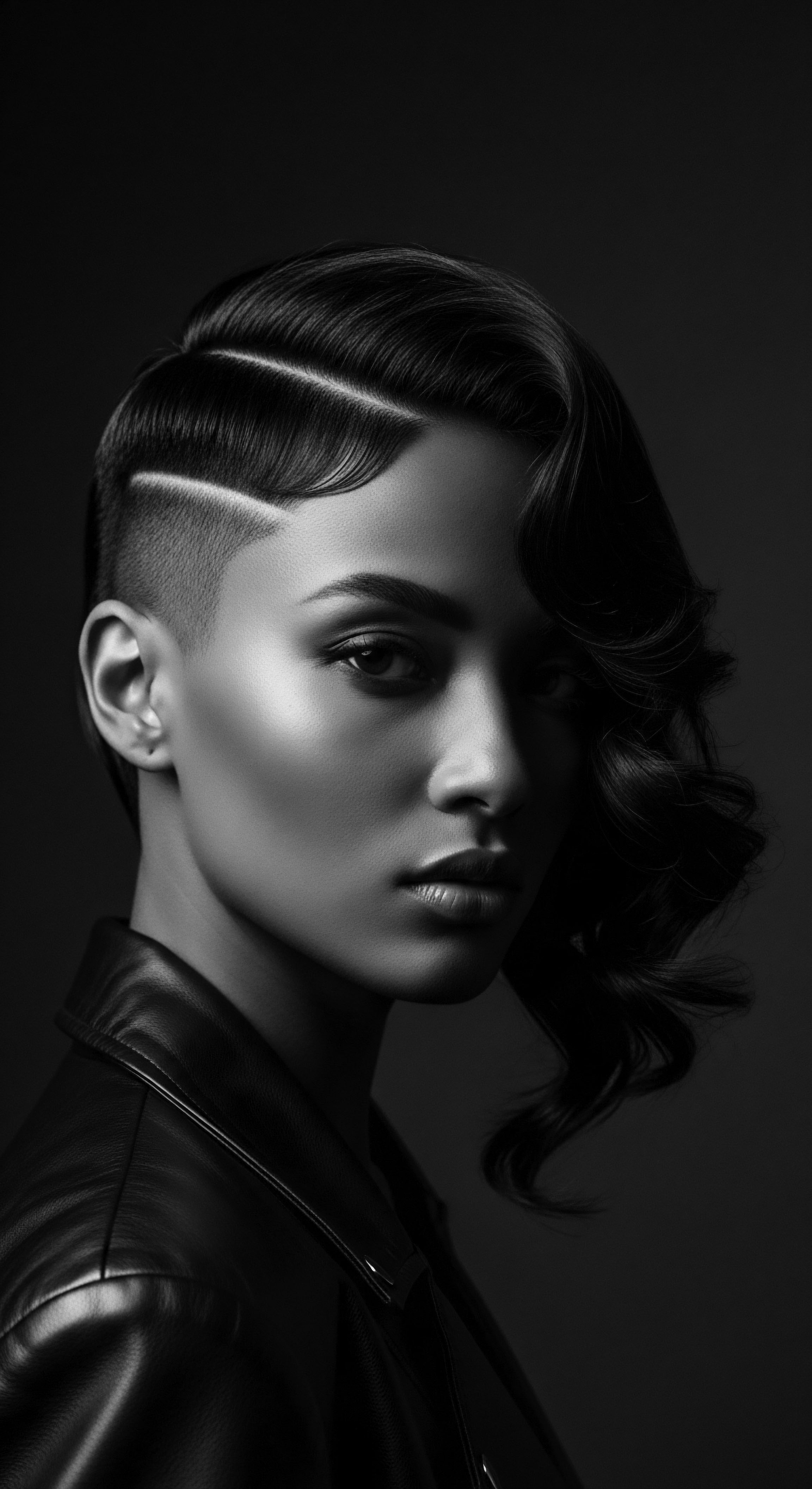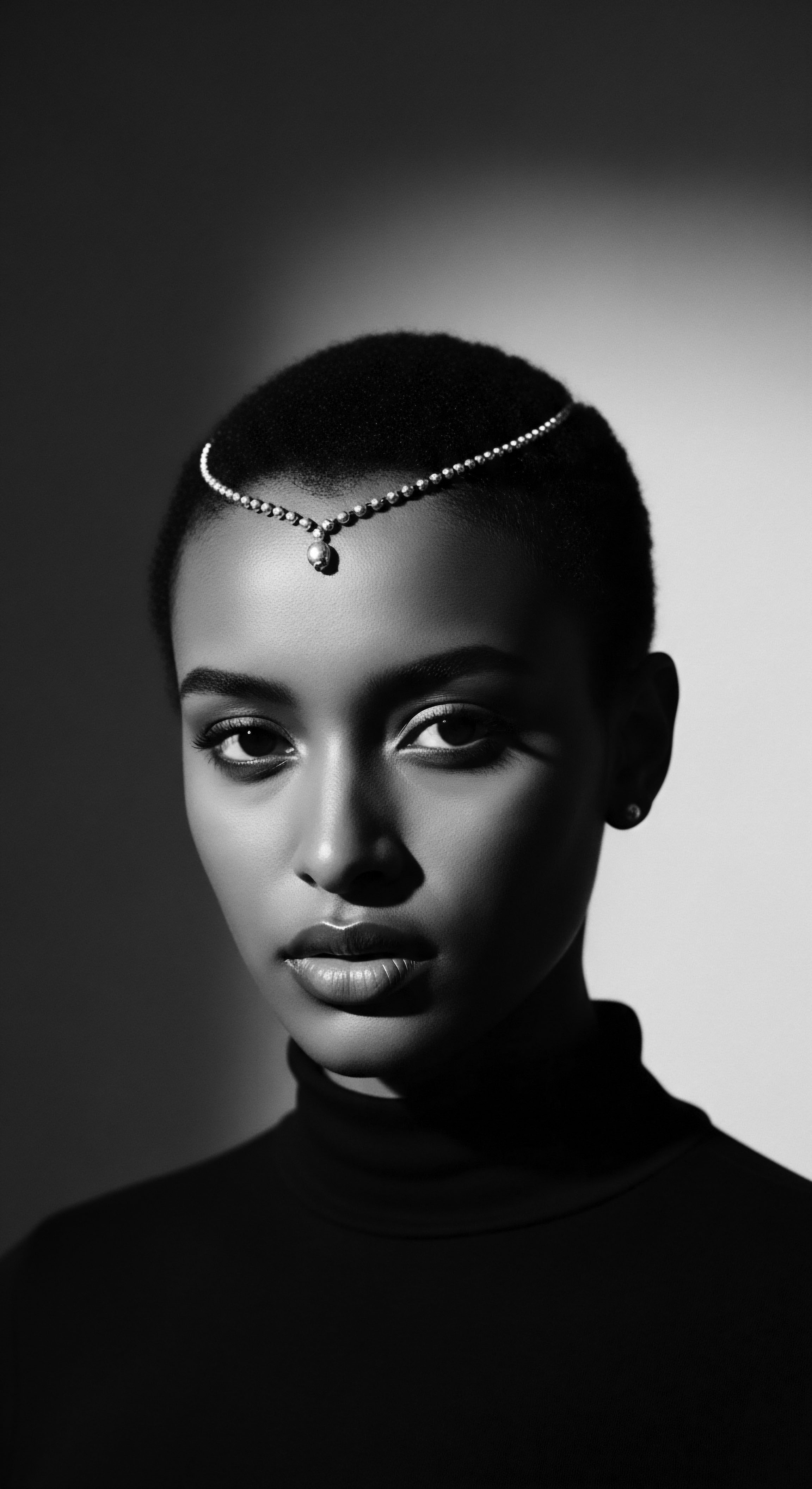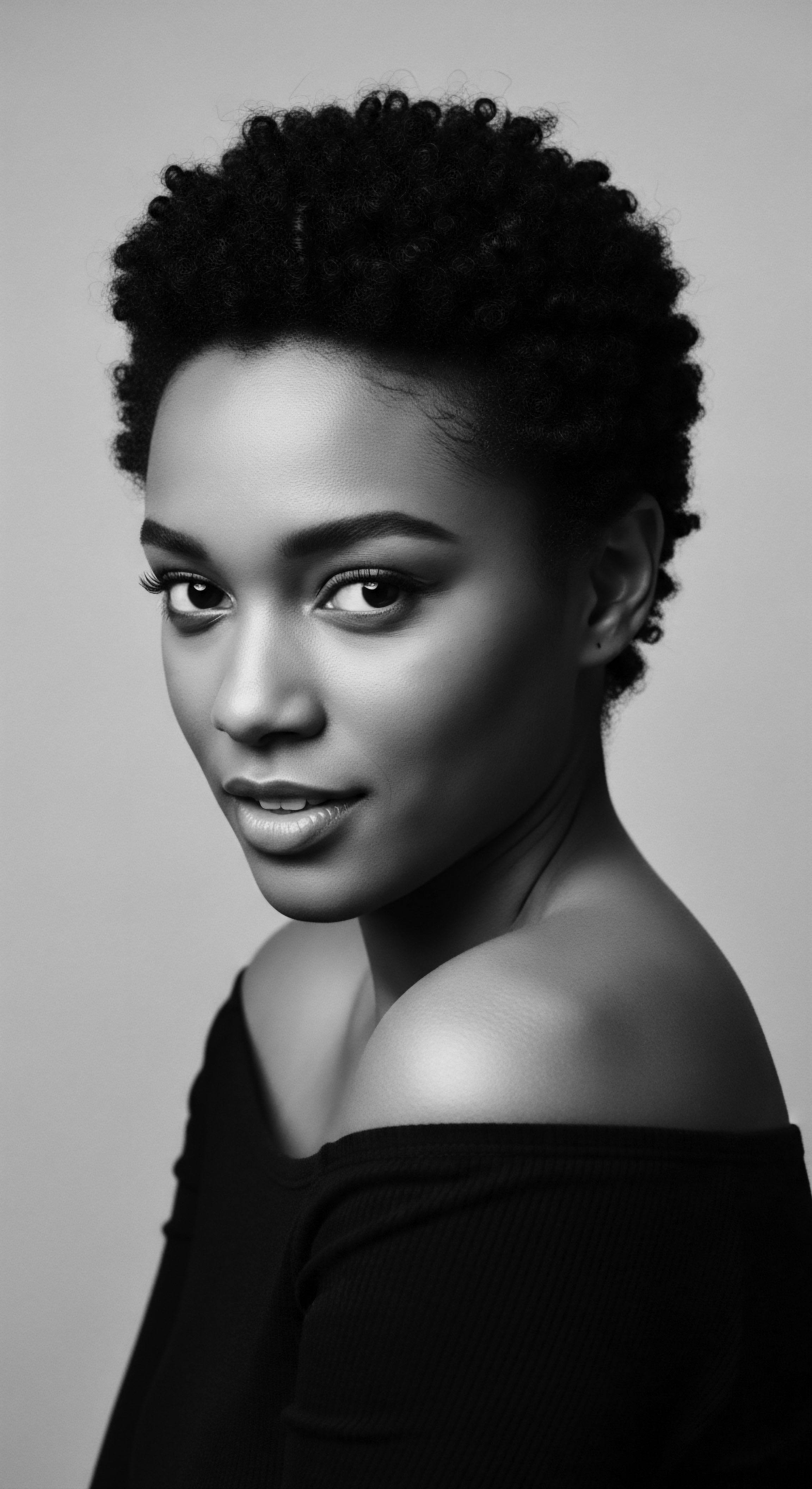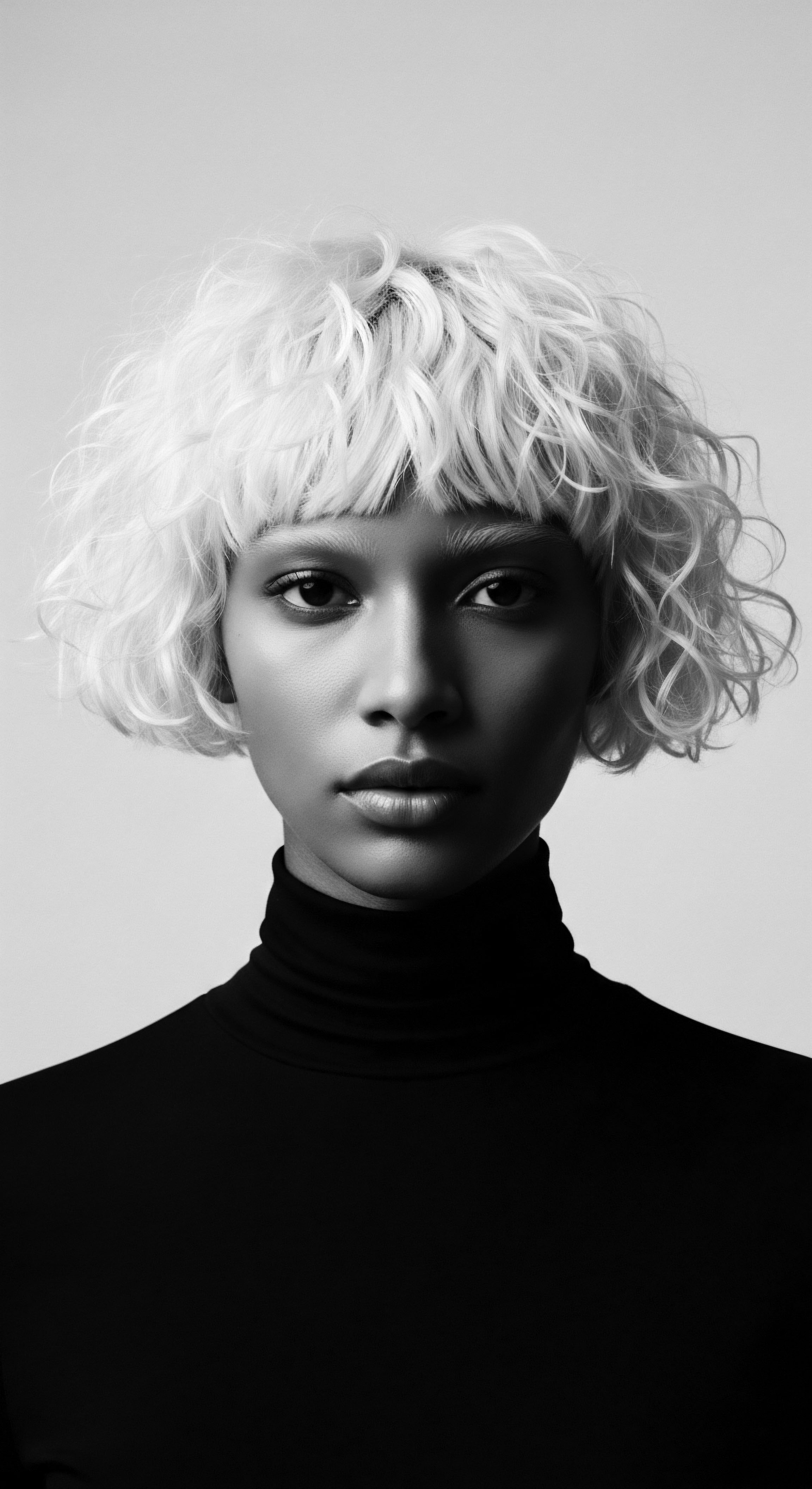
Roots
The coil, the curl, the zigzag—each strand of textured hair holds within its very structure echoes of journeys spanning continents and generations. This hair, so uniquely formed, tells a story far older than any styling tool, a story of sun-kissed lands, community rituals, and profound resilience. Yet, within this narrative, how do modern heat tools affect textured hair patterns? It is a question that reaches beyond immediate cosmetic concerns, touching upon the delicate balance of ancestral strength and the demands of contemporary life.
Consider the ancestral hair, shaped by climates and cultures, a natural marvel designed for protection and expression. For countless millennia, the intricate designs formed by braiding or coiling served as living records—maps to escape enslavement, identifiers of tribal affiliation, age, and marital status, or symbols of spiritual connection. This heritage is not a static relic; it is a vibrant, continuing presence within each wave and coil, influencing how hair responds to everything, including the application of heat.

Hair’s Intrinsic Form
Textured hair, characterized by its elliptical cross-section and its spiral growth from the scalp, possesses a unique architecture. Unlike straight hair, which tends to be round in cross-section, the flattened oval shape of textured strands creates natural bends and twists. This structural particularity results in fewer cuticle layers, making textured hair inherently more susceptible to moisture loss and external damage.
The cuticle, the outermost protective layer, consists of overlapping keratin scales, much like roof tiles. When healthy, these scales lie flat, locking in moisture and reflecting light, creating natural luster.
The enduring legacy of textured hair lies in its inherent strength and historical symbolism.
Heat tools—blow dryers, curling irons, flat irons—deliver thermal energy directly to the hair shaft. This energy primarily impacts the hair’s protein structure, specifically the keratin within the cortex. Keratin, the primary protein component, has a natural coiled structure known as the alpha helix. When exposed to temperatures surpassing a certain threshold, often above 400°F (200°C), this alpha helix begins to melt, a process scientists term protein denaturation.

How Does Extreme Heat Change Hair’s Structure?
Protein denaturation fundamentally alters the hydrogen bonds that maintain the hair’s natural curl pattern. These bonds, while strong enough to hold the hair’s shape, are relatively fragile when confronted with high temperatures. The temporary breaking of these bonds allows the hair to be reshaped—from coiled to straight, for instance.
Yet, if the heat is too intense or applied too frequently, this alteration becomes irreversible. The keratin proteins lose their inherent strength and elasticity, leading to what is commonly known as heat damage.
The impact goes further than merely reshaping. Elevated heat can cause the cuticle scales to lift, crack, or even disappear completely, exposing the more vulnerable inner cortex. An exposed cortex loses moisture rapidly, contributing to dryness, brittleness, and a rough texture. The hair becomes more prone to tangling and breakage, and its natural elasticity diminishes.
The very physical properties of textured hair, those that contributed to its resilience in ancestral environments, render it particularly vulnerable to the persistent, intense application of heat. The coils and bends mean that heat distribution can be uneven, and the inherent dryness of highly textured strands makes them more susceptible to moisture loss when heat is applied.

Ancestral Understandings and Modern Science
Long before the advent of modern heat tools, ancestral hair care practices were deeply intertwined with preserving hair’s integrity and promoting its health within its natural state. These practices, passed down through oral traditions and communal rituals, relied on natural ingredients and gentle handling, often emphasizing moisture retention. The wisdom of these forebears, gleaned from centuries of observation, instinctively countered the very issues modern heat tools present. They understood the hair’s need for hydration and protection without formal scientific vocabulary.
- Botanical Treatments ❉ The use of various plant-based oils, butters, and herbs, such as shea butter, coconut oil, aloe vera, and neem, was fundamental for nourishment and protection.
- Gentle Detangling ❉ Practices like finger separation or the use of wide-tooth combs, often while hair was saturated with natural emollients, prevented undue stress on delicate strands.
- Protective Styling ❉ Braids, twists, and coiling methods were not only aesthetic expressions but also served to safeguard the hair from environmental elements and mechanical abrasion.
Understanding the foundational biology of textured hair, especially its unique structure and inherent moisture needs, provides a lens through which to evaluate the historical and contemporary relationship with heat. This context invites a more mindful approach to heat styling, one that respects the hair’s ancient blueprint and guards its future health.

Ritual
The journey of textured hair through history is a chronicle of adaptation, expression, and unwavering spirit. From the intricate coiffures of ancient African kingdoms to the enduring styles of the diaspora, hair has always been a canvas for identity. The advent of heat tools introduced a new chapter in this story, one where the pursuit of certain aesthetic ideals sometimes intersected with the need for convenience, and at times, with complex societal pressures. How does heat styling, in its various forms, fit into this rich tapestry of textured hair’s styling heritage?

The Hot Comb’s Historical Echoes
The hot comb, often mistakenly attributed to Madam C.J. Walker, holds a particular place in the history of textured hair styling. While its origins trace to late 19th-century France, where Marcel Grateau developed heated tools for styling European hair, it was African American entrepreneurs like Annie Malone and Madam C.J.
Walker who significantly popularized and refined the hot comb within the Black community. These visionary women recognized a need and built empires by integrating the hot comb into comprehensive hair care systems designed for Black women.
The hot comb, a tool of complex legacy, reshaped styling practices within the Black community for generations.
The practice of ‘pressing’ hair with a heated comb became a widely adopted ritual throughout the 20th century. For many, it represented a means to achieve smoother, straighter styles that aligned with prevailing Eurocentric beauty standards—standards that unfortunately linked straighter hair to greater social acceptance and economic opportunity. The smoky smell of heated hair and the rhythmic sizzle against a damp cloth are common recollections for generations of Black women, a shared memory of Sunday mornings or special occasions. This practice, however, was not without its risks, including burns and potential hair damage.
Beyond the hot comb, the mid-20th century brought the widespread use of chemical relaxers, a more permanent form of straightening, followed by the evolution of flat irons and curling wands. Each tool, in its own way, allowed for transformations, offering versatility but also demanding a new understanding of hair’s vulnerability to thermal stress.

Modern Heat Styling and Ancestral Wisdom
Contemporary heat styling, whether through blow dryers, flat irons, or curling wands, continues the legacy of hair transformation. These tools operate on the principle of breaking and reforming hydrogen bonds within the hair’s keratin structure, allowing the natural curl pattern to be temporarily altered. The challenge, particularly for textured hair, arises from its unique architecture. The natural coils and turns mean that heat must be applied carefully to reach all areas, and the inherent tendency of textured hair towards dryness can be exacerbated by the evaporation of moisture during heating.
The dangers of excessive or unprotected heat application are clear. Prolonged exposure can lead to irreversible damage, including protein denaturation and cuticle impairment, resulting in dryness, brittleness, and a loss of the hair’s natural elasticity. This damage, often called “heat damage,” manifests as a weakened hair shaft and a compromised curl pattern, where coils may not revert to their original shape even after washing.

A Contrast in Approach to Hair Care
Historically, many ancestral cultures valued the preservation of hair’s natural form, understanding its protective and communicative functions. Their tools were crafted from natural materials, emphasizing gentle manipulation and adornment rather than drastic alteration of texture.
| Aspect Primary Goal |
| Ancestral Hair Practices Preservation of natural texture, health, cultural identity |
| Modern Heat Styling (Textured Hair) Temporary alteration of texture, styling versatility, perceived conformity to certain aesthetics |
| Aspect Tools Used |
| Ancestral Hair Practices Fingers, wide-tooth combs, natural fiber brushes, adornments like beads, shells, clay |
| Modern Heat Styling (Textured Hair) Hot combs, flat irons, blow dryers, curling wands, chemical relaxers |
| Aspect Focus |
| Ancestral Hair Practices Hydration, protection from elements, communal rituals, symbolic expression |
| Modern Heat Styling (Textured Hair) Reshaping, temporary smoothing, quick styling, achieving specific looks |
| Aspect Potential Impact |
| Ancestral Hair Practices Maintained hair integrity, communal bonding, cultural continuity |
| Modern Heat Styling (Textured Hair) Protein damage, cuticle lifting, moisture loss, loss of curl pattern, scalp irritation |
| Aspect The divergence in practices reflects differing historical contexts and beauty ideals, with ancestral methods prioritizing the hair's inherent health and cultural meaning. |
The conscious choice to integrate heat styling into a textured hair care regimen necessitates a deep understanding of these historical and scientific realities. It calls for a balanced approach, one that respects the hair’s inherent structure while still allowing for personal expression through styling. Choosing lower heat settings, utilizing appropriate heat protectants, and limiting frequency are critical steps in mitigating potential harm.
For many, the act of heat styling has been intertwined with a desire for social acceptance, a legacy of the unfortunate association of straight hair with professionalism and beauty. However, the growing natural hair movement, a reclamation of ancestral heritage, challenges these norms, creating a space where textured hair in its un-manipulated state is celebrated as beautiful and powerful. This cultural shift invites a re-evaluation of styling choices, encouraging a conscious decision regarding how much, and why, heat tools are used.

Relay
The enduring spirit of textured hair care, passed down through generations, represents a living archive of wisdom. How do heat tools affect textured hair patterns within the context of holistic care, a philosophy deeply rooted in ancestral practices and modern understanding? This inquiry probes beyond surface-level techniques, examining the lasting effects on hair’s integrity and the conscious choices individuals make to preserve their hair’s heritage.

The Science of Thermal Alteration
When heat interacts with textured hair, a complex cascade of physical and chemical changes ensues. The primary components of hair, namely Keratin Proteins, are susceptible to temperatures that can cause structural alterations. Hair’s natural elasticity and curl definition derive from its hydrogen bonds and disulfide bonds.
While hydrogen bonds are temporary and can be reformed with water (hence, heat-straightened hair reverts when wet), extreme heat can cause irreversible damage to the more stable disulfide bonds and the overall protein matrix. This process, known as protein denaturation, leads to a significant loss of hair strength and elasticity.
A telling manifestation of this damage is the phenomenon of Heat Training, where repeated application of heat at high temperatures causes the curl pattern to loosen or even disappear permanently. This is not a beneficial alteration; rather, it indicates structural compromise. The outermost layer, the hair cuticle, lifts and cracks under heat exposure, leaving the inner cortex exposed and vulnerable.
Such a compromised cuticle struggles to retain moisture, leading to persistent dryness, brittleness, and increased susceptibility to breakage. The loss of the natural curl pattern can be particularly disheartening, representing a disconnection from the hair’s inherent design and ancestral identity.

A Historical Example of Hair Alteration and Societal Pressure
The historical context of hair straightening, particularly for Black women, cannot be overstated when discussing heat tools. Following the abolition of slavery, there was immense societal pressure for Black individuals to conform to Eurocentric beauty standards to achieve social and economic advancement. This led to the widespread adoption of tools like the hot comb and later, chemical relaxers. A 2017 study found that Black women experienced more anxiety about their hair and were twice as likely as white women to feel compelled to straighten their hair in professional settings.
This statistic underscores a deep-seated legacy where hair texture was, and sometimes remains, a determinant of perceived professionalism and acceptance, driving choices that could compromise hair health. This pressure often pushed individuals to use heat tools to a degree that resulted in considerable damage, sometimes leading to significant hair loss or scalp conditions.
This historical reality illuminates a crucial aspect of how heat tools affect textured hair patterns ❉ it is not always a purely aesthetic choice. It has often been a response to systemic discrimination and deeply ingrained societal biases against natural textured hair. Understanding this history allows for a more compassionate and informed approach to the topic, one that prioritizes hair health and self-acceptance over imposed standards.

Ancestral Practices for Hair Preservation
In stark contrast to the modern reliance on high heat, ancestral communities across the African diaspora cultivated sophisticated hair care practices that emphasized moisture, protection, and gentle manipulation. These traditions speak to a profound, intuitive understanding of hair biology, long before scientific instruments could dissect keratin bonds.
- Oils and Butters for Protection ❉ Traditionally, emollients such as Shea Butter from West Africa, Argan Oil from North Africa, or Coconut Oil, used in various tropical regions, were applied to lubricate the hair shaft and scalp. This created a natural barrier against environmental stressors and helped seal in moisture, mitigating dryness, a predisposition of textured hair.
- Protective Styles ❉ Complex braiding and coiling styles, like Bantu knots, cornrows, and various forms of locs, were more than decorative. They minimized tangling, reduced exposure to external elements, and lessened daily manipulation, thereby preserving hair’s length and strength. These styles were often communal acts, strengthening familial and social ties.
- Natural Cleansers and Rinses ❉ Instead of harsh detergents, ancestral methods often used natural clays like Rhassoul Clay or acidic rinses from ingredients such as Hibiscus or Apple Cider Vinegar to cleanse gently without stripping essential oils. This maintained the delicate moisture balance crucial for textured strands.

Holistic Influences on Hair Health
The ancestral approach to hair health was inherently holistic, recognizing that external care reflects internal wellbeing. This philosophy stands as a guiding principle in mitigating the negative effects of heat tools. It posits that a truly radiant head of hair begins from within, nourished by mindful choices that echo ancient wisdom.
A central tenet of this holistic perspective is the preservation of hair’s natural hydration. Heat, by its very nature, causes water to evaporate from the hair shaft. This can leave textured hair, which already tends to be drier due to its structural configuration, especially parched. Rebalancing this moisture is paramount.
Nighttime rituals, for instance, play a significant role in this preservation. The use of Silk or Satin Bonnets or pillowcases, a practice with historical roots in protecting coiffures and preserving hair health, reduces friction against rough cotton surfaces that can cause cuticle damage and moisture loss during sleep. This simple, yet powerful, tradition safeguards the hair’s integrity against mechanical abrasion, allowing it to retain its natural curl pattern and moisture.
Problem-solving for heat-damaged textured hair, therefore, moves beyond superficial treatments. It demands a recalibration towards restorative practices. This includes deep conditioning treatments, often infused with traditional moisturizing ingredients, to replenish lost hydration and fortify the compromised hair structure. Protein treatments, judiciously applied, can also help to temporarily reinforce weakened protein bonds.
Ultimately, for severe heat damage where the curl pattern is permanently altered and breakage is rampant, the most direct path to healthier hair remains trimming the damaged portions, allowing healthy, uncompromised hair to thrive. This act, while sometimes challenging, represents a conscious decision to sever ties with damage and reconnect with the hair’s natural, resilient heritage.

Reflection
The journey through the intricate relationship between heat tools and textured hair patterns reveals far more than mere cosmetology. It speaks to a profound dialogue between modern innovation and an enduring heritage, a conversation that has shaped personal identity and communal expression across generations. Roothea’s ‘Soul of a Strand’ ethos reminds us that each coil and curve carries not only its biological blueprint but also the silent echoes of ancestral wisdom, resilience, and cultural narratives.
Our exploration has laid bare the scientific realities of thermal alteration, demonstrating how high temperatures can irrevocably change the very protein structure that gives textured hair its distinctive beauty. Yet, this understanding is incomplete without acknowledging the historical currents that have often compelled the use of such tools—the pervasive influence of Eurocentric beauty standards, the pursuit of perceived social acceptance, and the economic pressures that have long informed hair choices within Black and mixed-race communities.
To look upon textured hair is to see a living archive, a testament to adaptability and creative spirit. The call to honor this heritage today means recognizing the tools and techniques of the past, both those that nurtured and those that, by necessity or imposition, caused harm. It means drawing upon ancestral care rituals that prioritize nourishment, protection, and the intrinsic health of the hair. It calls for a conscious return to ingredients and practices that align with the hair’s natural inclinations, understanding that true radiance springs from respect for its origins.
The future of textured hair care, therefore, is not solely about advanced products or styling trends. It rests on a deeper appreciation for its historical weight, its cultural symbolism, and its inherent physiological needs. It is about fostering a relationship with one’s hair that is rooted in self-acceptance, informed by knowledge, and guided by the timeless wisdom of generations past. This conscious approach empowers individuals to choose practices that celebrate the authenticity of their hair, ensuring that the legacy of textured hair continues to be one of strength, beauty, and unwavering pride.

References
- Aguh, Crystal, and Emma G. Garza. “Hairstyling practices popular among African-American women increase risk of hair loss.” Johns Hopkins Medicine, 2016.
- Byrd, Ayana, and Lori Tharps. Hair Story ❉ Untangling the Roots of Black Hair in America. St. Martin’s Press, 2001.
- Essel, Osuanyi Quaicoo. “Conflicting Tensions in Decolonising Proscribed Afrocentric Hair Beauty Culture Standards in Ghanaian Senior High Schools.” International Journal of Research and Scientific Innovation, vol. 8, no. 3, 2021, pp. 116-125.
- Gubelin, E. “The Forensic Aspects of Hair.” Journal of the Forensic Science Society, vol. 18, no. 1-2, 1978, pp. 129-136.
- Johnson, Sheri. “The History of Black Hair and Beauty ❉ From Slavery to the Natural Hair Movement.” African American History & Culture National Museum of African American History and Culture.
- Khumalo, Ncoza D. et al. “What is normal black African hair? A light and scanning electron-microscopic study.” Journal of the American Academy of Dermatology, vol. 43, no. 5, 2000, pp. 814-820.
- L’Oréal Research and Innovation. “Understanding Hair Damage ❉ From Cuticle to Cortex.” L’Oréal Scientific Publication, 2022.
- Martin, Susan Taylor. “Sizzle.” National Museum of African American History and Culture, 2019.
- McMichael, Amy J. et al. “Hair care practices ❉ A review of the risks associated with certain ethnic hair styles.” Dermatologic Clinics, vol. 27, no. 3, 2009, pp. 329-339.
- Muhammad, Beverly. The Black Woman’s Guide to Great Hair. One World/Ballantine, 2003.
- Robbins, Clarence R. Chemical and Physical Behavior of Human Hair. 5th ed. Springer, 2012.
- Smalls, F.S. “Rhetoric of Natural Hair ❉ Cultural Contradictions.” Open Journal of Social Sciences, vol. 4, no. 6, 2016, pp. 1-13.
- Taylor, Larry Jr. “Unveiling the Hidden Dangers ❉ Hair Relaxers and Their Alarming Connection to Cancer.” Mesothelioma.com, 2024.
- Thompson, Marilyn. Hair Story ❉ The Transformation of Black Hair. St. Martin’s Press, 2009.
- Walker, A’Lelia Bundles. On Her Own Ground ❉ The Life and Times of Madam C.J. Walker. Scribner, 2001.
